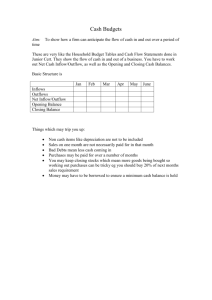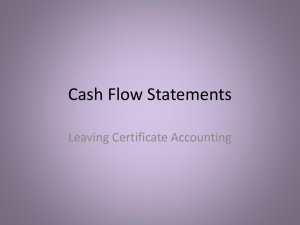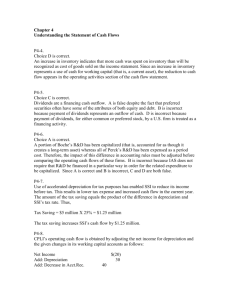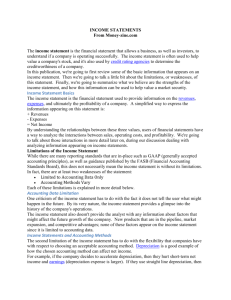A Understanding Cash Flow Analysis File C3-14 December 2009
advertisement
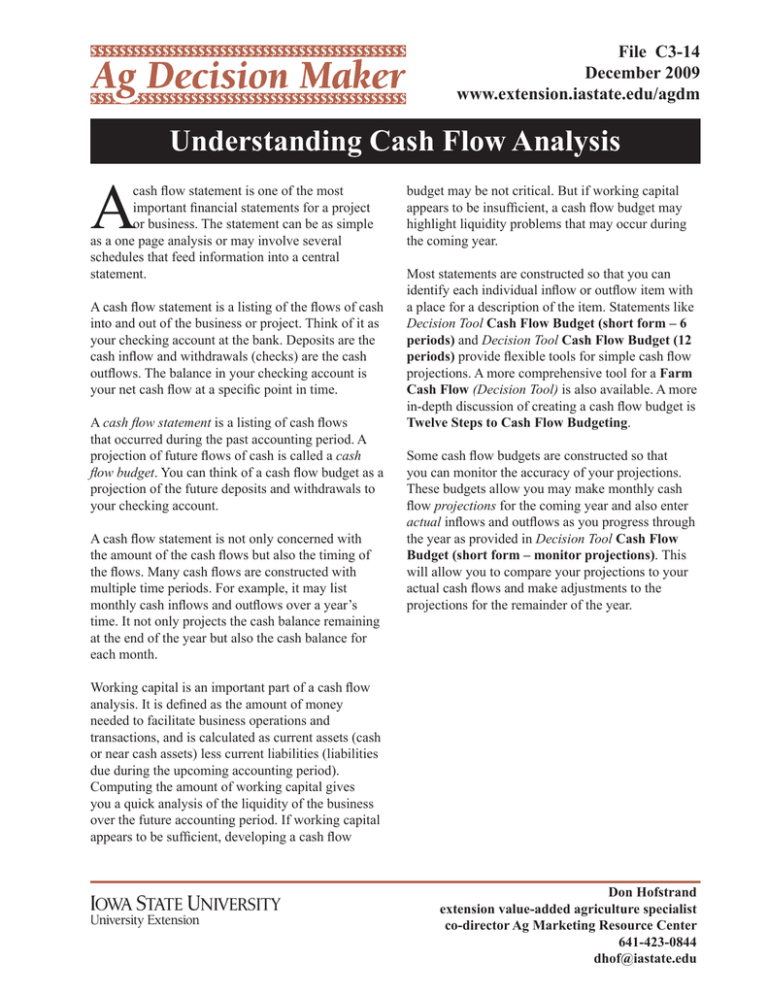
File C3-14 December 2009 www.extension.iastate.edu/agdm Understanding Cash Flow Analysis A budget may be not critical. But if working capital appears to be insufficient, a cash flow budget may highlight liquidity problems that may occur during the coming year. A cash flow statement is a listing of the flows of cash into and out of the business or project. Think of it as your checking account at the bank. Deposits are the cash inflow and withdrawals (checks) are the cash outflows. The balance in your checking account is your net cash flow at a specific point in time. Most statements are constructed so that you can identify each individual inflow or outflow item with a place for a description of the item. Statements like Decision Tool Cash Flow Budget (short form – 6 periods) and Decision Tool Cash Flow Budget (12 periods) provide flexible tools for simple cash flow projections. A more comprehensive tool for a Farm Cash Flow (Decision Tool) is also available. A more in-depth discussion of creating a cash flow budget is Twelve Steps to Cash Flow Budgeting. cash flow statement is one of the most important financial statements for a project or business. The statement can be as simple as a one page analysis or may involve several schedules that feed information into a central statement. A cash flow statement is a listing of cash flows that occurred during the past accounting period. A projection of future flows of cash is called a cash flow budget. You can think of a cash flow budget as a projection of the future deposits and withdrawals to your checking account. A cash flow statement is not only concerned with the amount of the cash flows but also the timing of the flows. Many cash flows are constructed with multiple time periods. For example, it may list monthly cash inflows and outflows over a year’s time. It not only projects the cash balance remaining at the end of the year but also the cash balance for each month. Some cash flow budgets are constructed so that you can monitor the accuracy of your projections. These budgets allow you may make monthly cash flow projections for the coming year and also enter actual inflows and outflows as you progress through the year as provided in Decision Tool Cash Flow Budget (short form – monitor projections). This will allow you to compare your projections to your actual cash flows and make adjustments to the projections for the remainder of the year. Working capital is an important part of a cash flow analysis. It is defined as the amount of money needed to facilitate business operations and transactions, and is calculated as current assets (cash or near cash assets) less current liabilities (liabilities due during the upcoming accounting period). Computing the amount of working capital gives you a quick analysis of the liquidity of the business over the future accounting period. If working capital appears to be sufficient, developing a cash flow Don Hofstrand extension value-added agriculture specialist co-director Ag Marketing Resource Center 641-423-0844 dhof@iastate.edu Page 2 File C3-14 Sample 1. Cash flow budget (by quarter of the year). Cash inflow Beginning cash balance Sale of crop products Sale of livestock products Government payments Total inflow Cash expenditures Seed Fertilizer Feed Processing Marketing Capital purchases Interest Debt payments Total expenditures First Q $5,000 Second Q Third Q Fourth Q $50,000 25,000 $30,000 $10,000 $10,000 $50,000 $10,000 $20,000 10,000 $10,000 $5,000 10,000 $20,000 $30,000 5,000 10,000 $25,000 Quarterly net cash flow $10,000 Cummulative net cash flow $10,000 $20,000 $30,000 -$25,000 $5,000 Reasons for Creating a Cash Flow Budget Think of cash as the ingredient that makes the business operate smoothly just as grease is the ingredient that makes a machine function smoothly. Without adequate cash a business cannot function because many of the transactions require cash to complete them. By creating a cash flow budget you can project your sources and applications of funds for the upcoming time periods. You will identify any cash deficit periods in advance so you can take corrective actions now to alleviate the deficit. This may involve shifting the timing of certain transactions. It may also determine when money will be borrowed. If borrowing is involved, it will also determine the amount of cash that needs to be borrowed. Periods of excess cash can also be identified. This information can be used to direct excess cash into interest bearing assets where additional revenue can be generated or to scheduled loan payments. Cash Flow is Not Profitability People often mistakenly believe that a cash flow statement will show the profitability of a business or project. Although closely related, cash flow and $5,000 $5,000 $10,000 profitability are different. A cash flow statement lists cash inflows and cash outflows while the income statement lists income and expenses. A cash flow statement shows liquidity while an income statement shows profitability. Many income items are also cash inflows. The sales of crops and livestock are usually both income and cash inflows. The timing is also usually the same as long as a check is received and deposited in your account at the time of the sale. Many expense items are also cash outflow items. The purchase of livestock feed (cash method of accounting) is both an expense and a cash outflow item. The timing is also the same if a check is written at the time of purchase. However, there are many cash items that are not income and expense items, and vice versa. For example, the purchase of a tractor is a cash outflow if you pay cash at the time of purchase as shown in the example in Table 1. If money is borrowed for the purchase using a term loan, the down payment is a cash outflow at the time of purchase and the annual principal and interest payments are cash outflows each year as shown in Table 2. The tractor is a capital asset and has a life of more than one year. It is included as an expense item in Page 3 File C3-14 an income statement by the amount it declines in value due to wear and obsolescence. This is called depreciation. The cost of depreciation is listed every year. In the tables below a $70,000 tractor is depreciated over seven years at the rate of $10,000 per year. Depreciation calculated for income tax purposes can be used. However, to more accurately calculate net income, a realistic depreciation amount should be used to approximate the actual decline in the value of the machine during the year. In Table 2, where the purchase is financed, the amount of interest paid on the loan is included as an expense, along with depreciation, because interest is the cost of borrowing money. However, principal payments are not an expense but merely a cash transfer between you and your lender. Table 1. Tractor purchase - no borrowing. Purchase of a $70,000 tractor, no money borrowed, depreciated over seven years. Current Period Year 1 Year 2 Year 3 Year 4 Year 5 Year 6 Year 7 Total Cash Outflow $70,000 $70,000 Expense $10,000 10,000 10,000 10,000 10,000 10,000 10,000 $70,000 Table 2. Tractor purchase - borrowing. Purchase of a $70,000 tractor, $45,000 down payment, $25,000 paid over five year, seven percent interest, depreciated over seven years. Cash Outflow $45,000 Expense $0 Year 1 $5,000 principal $1,750 interest $10,000 depreciation $1,750 interest Year 2 $5,000 principal $1,400 interest $10,000 depreciation $1,400 interest Year 3 $5,000 principal $1,050 interest $10,000 depreciation $1,050 interest Year 4 $5,000 principal $700 interest $10,000 depreciation $700 interest Year 5 $5,000 principal $350 interest $10,000 depreciation $350 interest Year 6 $0 $10,000 depreciation Year 7 $0 $10,000 depreciation $75,250 $75,250 Current Period Total Page 4 File C3-14 Other Financial Statements claims against the business, i.e. debts. The amount by which assets exceed liabilities is the net worth of the business. The net worth reflects the current value of investment in the business by the owners. A cash flow statement is only one of several financial statements that can be used to measure the financial strength of a business. Other common statements include the balance sheet or Net Worth Statement and the Income Statement, although there are several other statements that may be included. The income statement is a dynamic statement that records income and expenses over the accounting period. The net income (loss) for the period increases (decreases) the net worth of the business (as shown in the ending balance sheet versus the beginning balance sheet). These statements fit together to form a comprehensive financial picture of the business. The balance sheet or net worth statement shows the solvency of the business at a specific point in time. Statements are often prepared at the beginning and ending of the accounting period (i.e. January 1). The statement records the assets of the business and their value and the liabilities or financial Figure 1. Integrated financial statements. Balance Sheet Balance Sheet Income Statement Cash Flow Statement Time A complete set of Financial Statements (Decision Tool), including the beginning and ending net worth statements, the income statement, the cash flow statement, the statement of owner equity and the financial performance measures is available to do a comprehensive financial analysis of your business. To help you assess the financial health of your business, Financial Performance Measures allows you to give your business a check-up. Interpreting Financial Performance Measures helps you to understand what these performance measures mean for your business. . . . and justice for all The U.S. Department of Agriculture (USDA) prohibits discrimination in all its programs and activities on the basis of race, color, national origin, gender, religion, age, disability, political beliefs, sexual orientation, and marital or family status. (Not all prohibited bases apply to all programs.) Many materials can be made available in alternative formats for ADA clients. To file a complaint of discrimination, write USDA, Office of Civil Rights, Room 326-W, Whitten Building, 14th and Independence Avenue, SW, Washington, DC 20250-9410 or call 202-720-5964. Issued in furtherance of Cooperative Extension work, Acts of May 8 and June 30, 1914, in cooperation with the U.S. Department of Agriculture. Jack M. Payne, director, Cooperative Extension Service, Iowa State University of Science and Technology, Ames, Iowa.
